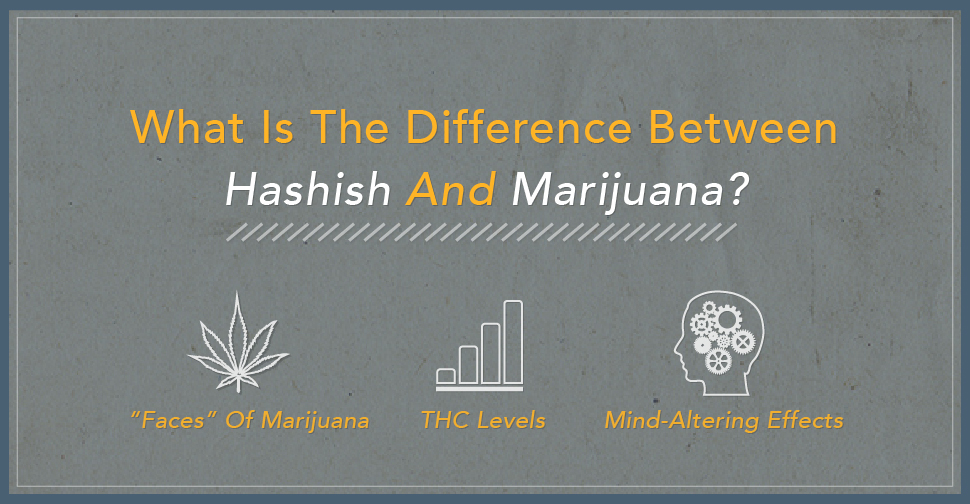Same Plant, Different Forms: How Hashish And Marijuana Differ
You have probably heard quite a fuss about marijuana. The drug has become increasingly well known—especially in the twenty-first century. Within the last decade, weed has become legalized in many states and countries around the world for both medicinal and recreational use. However, simply hearing about a drug does not erase valid questions about the details regarding a drug’s properties, what forms the drug comes in, and how the drug is used. In this article, we will explore these details as they apply to marijuana and hashish, while answering the following question: How are marijuana and hashish different?
The “Faces” Of Marijuana
Marijuana is identified by multiple nicknames (pot, dope, ganja, weed, and mary jane, just to name a few). In countless articles, weed is also referred to as hashish or hash. However, the identifying words for marijuana and those for hashish should not be used interchangeably, for the two are not one and the same.
Producing Weed VS Producing Hashish
Pot and hashish are made from the same plant: the female cannabis plant, cannabis sativa. But the process of how the two are created and the results of each are very different. In order to produce marijuana, the form of cannabis that is most common, the following steps are completed:
- Harvest female cannabis plant
- Dry flowering tops/buds (and sometimes the leaves) of plant
- Dried product is ready for medicinal or recreational use
In order to produce hashish, the steps are more involved:
- Harvest female cannabis plant
- Dry flowering tops/buds of plant
- Collect trichomes (fine, hair-like resin glands) at top of buds
- Filter plant with sieve to separate flower and resin
- Crush resin into powder by hand or with machine (this step releases oil and creates a tacky texture)
- Mold the now sticky resin into a ball or “brick”/slice
- Final brick is ready for use
How Pot And Hash Are Used
Marijuana and hashish are used in similar fashions. Both drugs can be smoked with a pipe, bong, or as a joint/blunt (like a cigarette). Hash and pot can also be consumed or ingested. For example, the dried product of marijuana is often added as an ingredient to food or even steeped in hot water to make tea.
Are you or a loved one suffering from addiction?
Don't wait, get the best treatment options today
Call Now: (833) 473-4227THC Levels In Hashish And Marijuana
Although hash and marijuana are used similarly, the two are greatly distinguished by the levels of THC (tetrahydrocannabinol) each product contains. Pot is the form of cannabis that most people are familiar with, but it is actually the least potent. THC, the active chemical of cannabis that affects the nervous system, is found in pot at a maximum level of 25 percent to 30 percent. Hash is often much stronger, ranging from 20 percent up to 60 percent. Many agree that hashish that is properly produced has a THC level that is three times as potent as pot.
Mind-Altering Effects Of THC
No matter the levels of THC in weed and hash, the chemical affects the brain in the same way. THC binds to a network of receptors in the brain and changes the state of the nervous system. Once marijuana or hashish are used, the brain responds within minutes. The notable short-term effects of these drugs are:
- Deficiencies in memory
- Difficulties in comprehension or learning
- Problems with general thinking and problem solving
- Increased heart rate
- Anxiety
- Decreased coordination
- Paranoia
- Panic attacks
Long-term effects of the use of these dangerous drugs include:
- Memory loss
- Permanent impairments in judgment
- Altered perception of surroundings
- Aggressive and/or rebellious behavior
- Respiratory problems
- Cravings, compulsive use, and addiction
The Reality For Those Who Enjoy Cannabis
The use of hashish and marijuana are becoming extremely common among adolescents and adults alike. It has been noted that approximately 14 percent of people within the United States have used a form of cannabis within the last month. Such increased social and cultural acceptance of the drug causes a more laid-back attitude associated with the serious effects—both short- and long-term—that THC induces. However, the magnitude of the effects should not be ignored.
Help Is Here
Information regarding the serious manner in which THC affects the brain is widespread. If you or someone you know is struggling with any of the difficulties listed above, or has even fallen into addictive behavior, there is help available. Immediate assistance is only a phone call away. Contact us at DrugRehab.org for any information regarding addiction or to get into a treatment facility that can set your life back on track.



